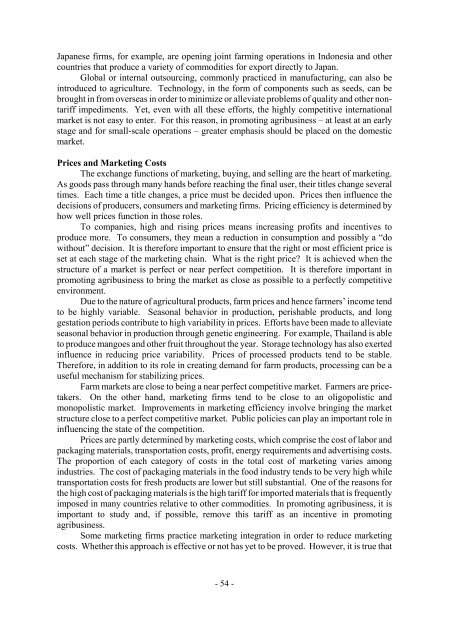Development of Agribusiness Enterprises - Asian Productivity ...
Development of Agribusiness Enterprises - Asian Productivity ...
Development of Agribusiness Enterprises - Asian Productivity ...
Create successful ePaper yourself
Turn your PDF publications into a flip-book with our unique Google optimized e-Paper software.
Japanese firms, for example, are opening joint farming operations in Indonesia and other<br />
countries that produce a variety <strong>of</strong> commodities for export directly to Japan.<br />
Global or internal outsourcing, commonly practiced in manufacturing, can also be<br />
introduced to agriculture. Technology, in the form <strong>of</strong> components such as seeds, can be<br />
brought in from overseas in order to minimize or alleviate problems <strong>of</strong> quality and other nontariff<br />
impediments. Yet, even with all these efforts, the highly competitive international<br />
market is not easy to enter. For this reason, in promoting agribusiness – at least at an early<br />
stage and for small-scale operations – greater emphasis should be placed on the domestic<br />
market.<br />
Prices and Marketing Costs<br />
The exchange functions <strong>of</strong> marketing, buying, and selling are the heart <strong>of</strong> marketing.<br />
As goods pass through many hands before reaching the final user, their titles change several<br />
times. Each time a title changes, a price must be decided upon. Prices then influence the<br />
decisions <strong>of</strong> producers, consumers and marketing firms. Pricing efficiency is determined by<br />
how well prices function in those roles.<br />
To companies, high and rising prices means increasing pr<strong>of</strong>its and incentives to<br />
produce more. To consumers, they mean a reduction in consumption and possibly a “do<br />
without” decision. It is therefore important to ensure that the right or most efficient price is<br />
set at each stage <strong>of</strong> the marketing chain. What is the right price? It is achieved when the<br />
structure <strong>of</strong> a market is perfect or near perfect competition. It is therefore important in<br />
promoting agribusiness to bring the market as close as possible to a perfectly competitive<br />
environment.<br />
Due to the nature <strong>of</strong> agricultural products, farm prices and hence farmers’ income tend<br />
to be highly variable. Seasonal behavior in production, perishable products, and long<br />
gestation periods contribute to high variability in prices. Efforts have been made to alleviate<br />
seasonal behavior in production through genetic engineering. For example, Thailand is able<br />
to produce mangoes and other fruit throughout the year. Storage technology has also exerted<br />
influence in reducing price variability. Prices <strong>of</strong> processed products tend to be stable.<br />
Therefore, in addition to its role in creating demand for farm products, processing can be a<br />
useful mechanism for stabilizing prices.<br />
Farm markets are close to being a near perfect competitive market. Farmers are pricetakers.<br />
On the other hand, marketing firms tend to be close to an oligopolistic and<br />
monopolistic market. Improvements in marketing efficiency involve bringing the market<br />
structure close to a perfect competitive market. Public policies can play an important role in<br />
influencing the state <strong>of</strong> the competition.<br />
Prices are partly determined by marketing costs, which comprise the cost <strong>of</strong> labor and<br />
packaging materials, transportation costs, pr<strong>of</strong>it, energy requirements and advertising costs.<br />
The proportion <strong>of</strong> each category <strong>of</strong> costs in the total cost <strong>of</strong> marketing varies among<br />
industries. The cost <strong>of</strong> packaging materials in the food industry tends to be very high while<br />
transportation costs for fresh products are lower but still substantial. One <strong>of</strong> the reasons for<br />
the high cost <strong>of</strong> packaging materials is the high tariff for imported materials that is frequently<br />
imposed in many countries relative to other commodities. In promoting agribusiness, it is<br />
important to study and, if possible, remove this tariff as an incentive in promoting<br />
agribusiness.<br />
Some marketing firms practice marketing integration in order to reduce marketing<br />
costs. Whether this approach is effective or not has yet to be proved. However, it is true that<br />
- 54 -
















